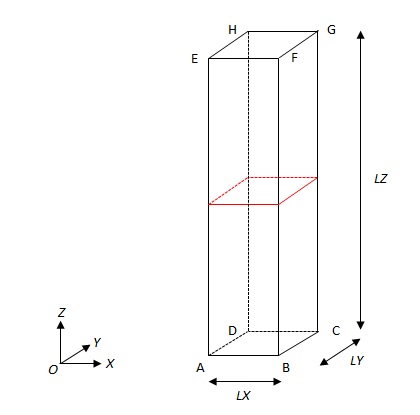1. Reference problem#
1.1. Geometry of the problem#
It is a column with height \(\mathit{LZ}=5m\), length \(\mathit{LX}=1m\), and width \(\mathit{LY}=1m\). In \(Z=\frac{\mathit{LZ}}{2}\), this column has an interface-type discontinuity. The column is thus entirely crossed by the discontinuity.
The geometry of the column is shown in the figure.

Figure 1.1-a : Problem geometry
1.2. Material properties#
The parameters given in the Table correspond to the parameters used for modeling in the hydromechanical coupled case. The coupling law used is” LIQU_SATU “. The parameters specific to this coupling law are given but have no influence on the solution (because we chose to take a uniformly zero pore pressure throughout the domain). Only the elastic parameters have an influence on the solution of the pseudo-coupled problem.
Liquid (water) |
Viscosity \({\mu }_{w}(\mathit{en}\mathit{Pa.s})\) Compressibility module \(\frac{1}{{K}_{w}}(\mathit{en}{\mathit{Pa}}^{\text{-1}})\) Liquid density \({\rho }_{w}(\mathit{en}\mathit{kg}\mathrm{/}{m}^{3})\) |
\({5.10}^{\text{-10}}\) \(1\) |
Elastic parameters |
Young’s modulus \(E(\mathit{en}\mathit{MPa})\) Poisson’s ratio \(\nu\) Thermal expansion coefficient \(\alpha (\mathit{en}{K}^{\text{-1}})\) |
\(0\) \(0\) |
Coupling parameters |
Biot coefficient \(b\) Initial homogenized density \({r}_{0}(\mathit{en}\mathit{kg}\mathrm{/}{m}^{3})\) Intrinsic permeability \({K}^{\text{int}}(\mathit{en}{m}^{2}/s)\) |
\(\mathrm{2,5}\) \({\mathrm{1,01937}}^{\text{-19}}\) |
Table 1.2-1 : Material Properties
On the other hand, the forces related to gravity (in the equation for the conservation of momentum) are neglected. The reference pore pressure is taken to be zero \({p}_{1}^{\text{ref}}=0\mathit{MPa}\) and the porosity of the material is \(\varphi =\mathrm{0,15}\).
We take \(\nu =0\) in order to have a one-dimensional problem in the \(y\) direction.
1.3. Boundary conditions#
The boundary conditions that can be applied to the domain are of two types:
Dirichlet-type conditions,
Neuman-type conditions.
Dirichlet’s conditions are:
on [ABCD] and [EFGH] the movements are blocked in all directions (\({u}_{\text{x}}=0\), \({u}_{\text{y}}=0\) and \({u}_{\text{z}}=0\)),
throughout the domain the pore pressure is zero \({p}_{1}=0\), as is the enriched degree of freedom associated with this pore pressure \({\mathit{Hp}}_{1}=0\).
Neuman’s conditions are:
on [ABCD] and [EFGH] the mass fluxes of water are zero \(M\mathrm{.}n=0\),
On each of the lips of the interface, a uniform distributed pressure is imposed \(p=10\mathit{MPa}\) by means of AFFE_CHAR_MECA and the keyword FISSURE of PRES_REP.
Gravity:
over the entire domain, the gravity volume load of intensity \(g=\mathrm{9,81}m\mathrm{.}{s}^{-2}\) is applied via AFFE_CHAR_MECA with the keyword CHAR_MECA_PESA_R.